Pink Pussycat
This page covers three related music venues:
- The Anglesey Cafe
- The Pink Pussycat
- The Filling Station
THE ANGLESEY CAFE
THE BUILDING
1327-1331 Hennepin Ave. (a/k/a 9 Spruce Place) was a three story brick veneer hotel built in 1907 at a cost of about $25,000. Its footprint was approximately 60′ by 90′. In 1915 the hotel became the 36-room Anglesey Apartments. The name Anglesey (often misspelled as Angelsey) came from an island off the northwest coast of Wales.
An Anglesey Cafe was mentioned once in April 1908.
1928
According to Cedric Adams’ column in 1953, the Anglesey was started in June 1928 by partners Joe Brush and George Sampanis. Brush was a well-known sportsman and hunter. (Minneapolis Star, June 11, 1953)
In 1928, a dramatic account of a shootout between proprietor George Sampanis and robbers blazed across the Minneapolis Star: “GUNS BARK AS CAFE OWNER DUELS BANDIT.” Despite the fact that Sampanis had a gun, the only casualties were a sugar bowl, the plate glass window, and lots and lots of dishes. The robbers got away with $121: money from the till, from Sampanis, and from the few customers in the place. (Minneapolis Star, May 28, 1928)
1930
Music from the Anglesey was broadcast over radio station WRHM.
1934
In 1934, Joseph S. Brush and Nick Sampanis (George’s cousin) were approved for a restaurant license. In 1935, they were approved for a license to sell intoxicating liquor, even though the Cafe was outside of the Liquor Patrol Limits.
Starting in 1934, the Cafe’s bowling team’s scores were in the paper every week.
1937
Again it’s a holdup that tells us who’s working at the Anglesey – at 5 am on February 27, 1937, a man climbbed into the building through a ventilator window and held up Tom Pappas, night man, and got away with $300 from two cash registers. The man failed to find an additional $500, but he did grab a handful of cigars as he made his escape back through the window. (Minneapolis Journal and Star, February 27, 1927)
1939
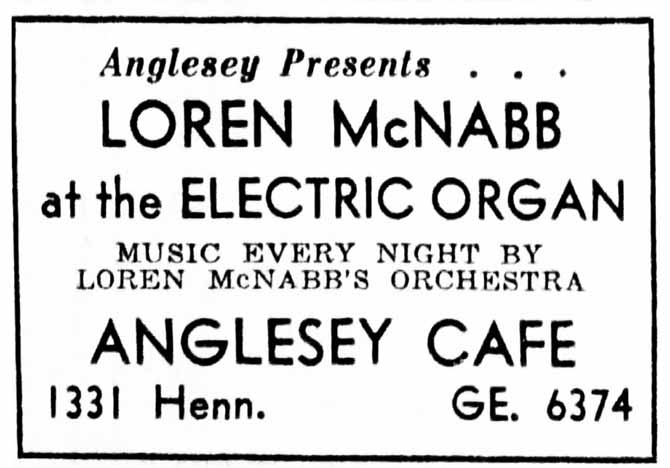
Minneapolis Star, January 20, 1939
In 1939, Eddie LaRue was the electric guitar playing leader of the four-piece house band at the Anglesey. Don Guthrie played an electronic keyboard called the Novachord, and the other two pieces were the clarinet and the “bull fiddle.” The band broadcast three days a week over phone lines over the radio. (Minneapolis Star, April 8 and June 27, 1939)
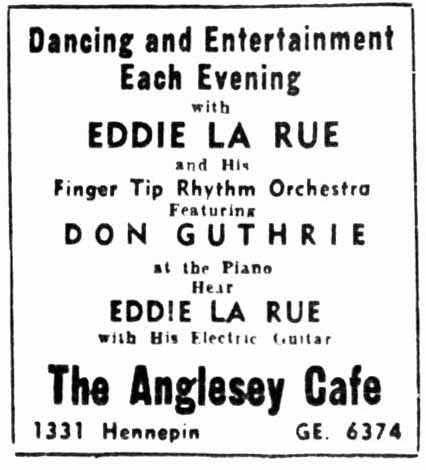
Minneapolis Tribune, February 7, 1939
The postcard below is undated, but perhaps it is of the era of this four piece band. We see the bass fiddle, and is that brown thing the Novochord?
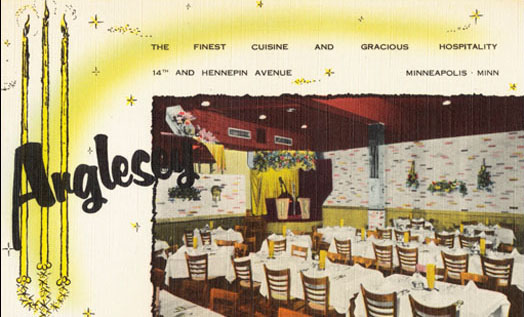
Image courtesy James Lilecs
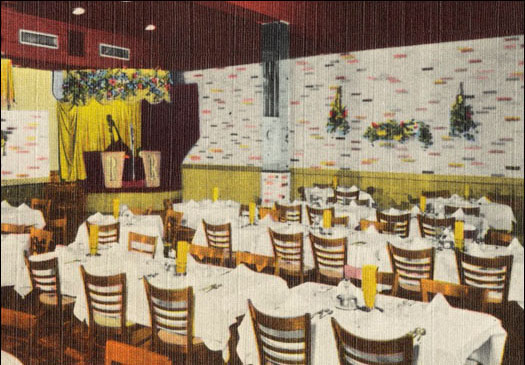
Here’s a closeup.
1940
The Cafe sponsored a Park Board baseball team and played teams sponsored by other bars and businesses, usually from Downtown Minneapolis.
Nick Sampanis, cousin of Joe Brush’s partner George Sampanis and co-holder of the original liquor license, died on August 4, 1940, at the age of 51. He was born in Greece and had spent 23 years working with George and Joe.
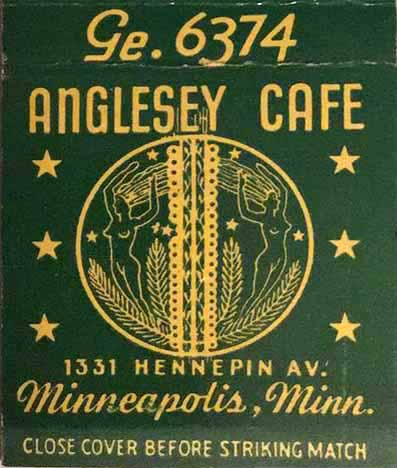
From the collection of Mark Youngblood
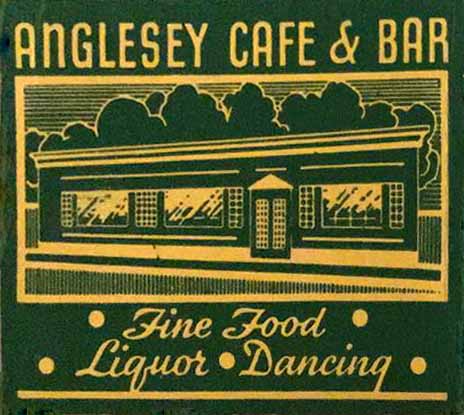
From the collection of Mark Youngblood
It would be nice to know that this is what the Anglesey looked like, except that we know it was on the first floor of a three-story building…
1941
Cedric Adams revealed this trick in his column:
Ever notice how thin the applause sounds from a supper club when the band goes into a broadcast or closes one? Joe Brush has solved the problem completely out at his Anglesey cafe. He copped the idea of Kitty Davis of giving each customer a little wooden mallet. During broadcast, Denny Beckner, the band leader, signals for applause, the patrons pound, and they sound like 2,000 enthusiasts. (Minneapolis Star, January 21, 1941)
If the mallets sound familiar, didn’t we see these in “Casablanca?”
Broadcasts from the Cafe were heard on WLOL radio.
An undated and unsigned memo (probably from the mid 1940s) says that the owner of record was the Minneapolis Bridge Co. but suspects that gangster Tommy Banks may have held the deed. (Clipping file, Hennepin County Library Special Collections)
Matchbook below from the collection of Mark Youngblood
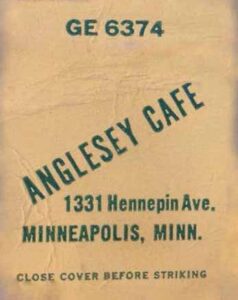
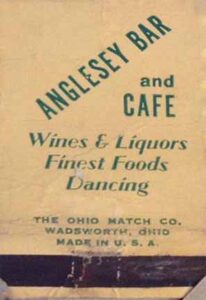
1945
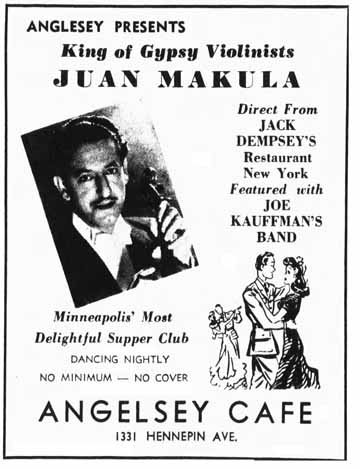
Minneapolis Daily Times, February 14, 1945
1946
In March 1946, owner George Sampanis was charged with discrimination by two black men who were not served at the bar. Each filed a $500 suit against Sampanis. The Minneapolis Spokesman reported that others had contacted the paper with complaints about discrimination. (Minneapolis Spokesman, March 15, 1946)
1947
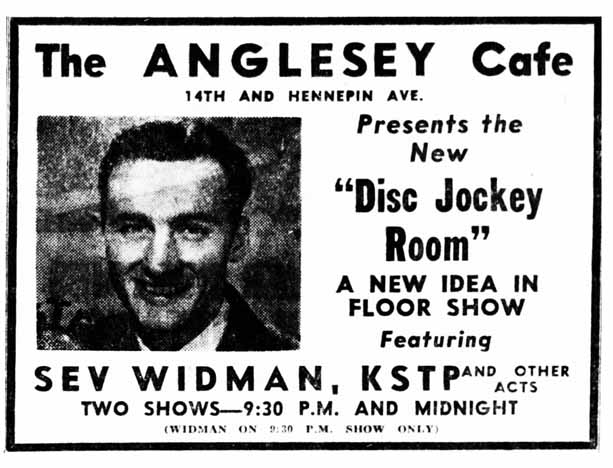
Minneapolis Star, June 12, 1947
In 1947, Sev Widman was emceeing the floor show in the new Disc Jockey Room. Will Jones described a couple of the vaudeville-type acts in his column that was mostly about the Cafe’s garlic bread. (Minneapolis Tribune, July 11, 1947)
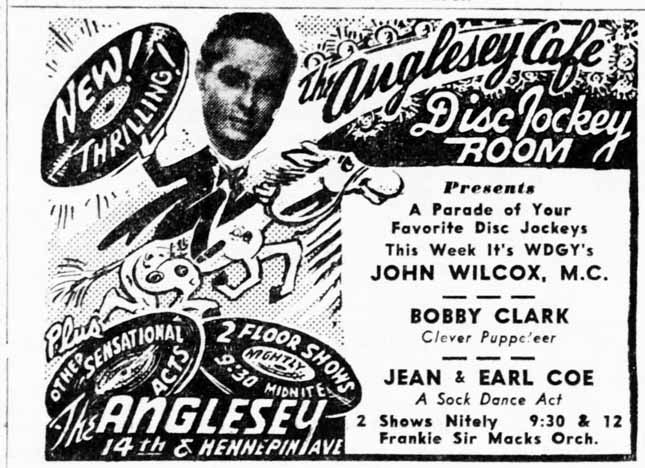
Minneapolis Star, June 17, 1947
1950
Air conditioning was added to the building in August 1950.
1953
Cedric Adams informs us that the Cafe was located in “automobile row,” and that owner Joe Brush has added a “nifty touch” called the Motor Lounge. The motif centered on antique cars and the days of early automobiling. The servers would wear dusters, caps, and goggles; prints of old cars would adorn the walls; small reproductions of early models would be scattered around the room, along with old headlamps, horns, and other motoring paraphernalia. A parade of 15 antique cars, valued at more than $75,000, was scheduled to tour “the loop” (Downtown) on opening night, September 1, and then park at the Anglesey for the night. (Minneapolis Star, August 28, 1953)
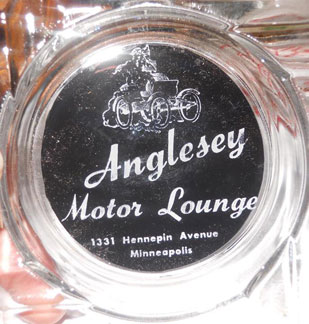
Ashtray from the collection of Mark Youngblood
Cedric Adams noted that June 1953 was the 25th Anniversary of the partnership between Joe Brush and George Sampanis “when they started their Anglesey cafe.” (Minneapolis Star, June 11, 1953) He was a little off, since we know that the place got robbed in May 1928, and what about that reference in 1908? The matchbook image below came from eBay and we can safely assume they are from 1953.
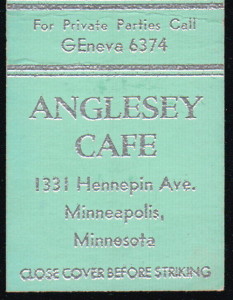
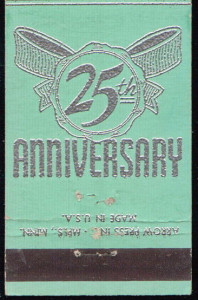
1955
One would think that it would be tough to rob a night club owned by a guy who is in the paper every week in the gun club section, but on August 5, 1955, the unthinkable happened: a gunman strolled into the Anglesey, unnoticed by nine customers and five employees, and robbed the cashier of $19,000 [16,000]. Authorities believed the holdup loot was the largest in Minneapolis since 1933, when members of the Roger Touhy gang of Chicago carried out a $78,000 mail robbery at the Milwaukee Depot.
Once the man had robbed the safe, which was full of check-cashing money, he locked the cashier in the safe, and she had to pound on the door until one of the bartenders heard her and called for Mrs. Brush to unlock the door.
At first the cashier was sure it was an ex-con who had just gotten out of prison, but he had an alibi, so the crime went unsolved. (Minneapolis Tribune, August 6, 1955)
On February 3, 1956, the same robber was back, but this time, the cashier foiled the attempt by ducking into a bullet-proof booth while the gunman fumbled for his revolver. Again, the only bartender and customer in the place didn’t notice the robber. “This is it again,” he said, as he pulled out his gun. But she was already in her safe cage and calling the police. (Minneapolis Tribune, February 4, 1956)
1957
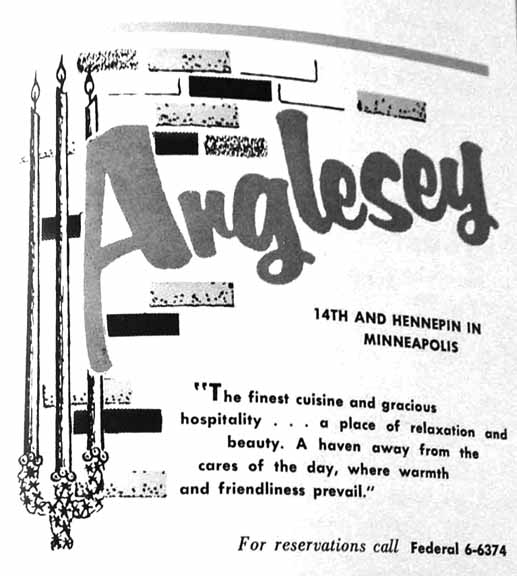
Image courtesy Mark Youngblood
1959
George Sampanis, Joe Brush’s partner since 1928, died on January 13, 1959, at the age of 66. George was born in Athens, and lived in Minneapolis for 49 years.
Jerry Henriksen was a violin player at the Angelsey for nine years before he was severely injured in a car accident in May 1958. After intense rehab, he was able to to play again, and Joe and Esther Brush kept his spot open for him. (George Grimm, Minneapolis Tribune, October 18, 1959)
1960
Joe Brush died on March 12, 1960, at the age of 62. Joe was born in Sheldon, Iowa, fought in World War I, and came to Minneapolis in 1925. He lived in the Anglesey Hotel, above the Cafe. He and wife Esther had a son, Joseph D.
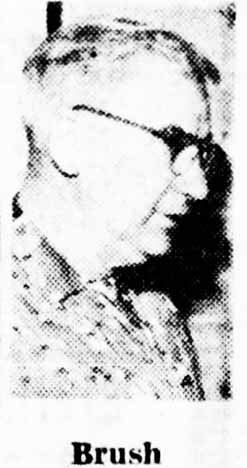
Joe Brush, Minneapolis Star, August 6, 1955
1962
On August 7, 1962, it was announced that Mrs. Harriet Sampanis and Mrs. Esther Brush, widows of the Anglesey’s founders George Sampanis and Joseph S. Brush, sold the building for $285,000. Purchasers were John Milne, former field representative for Minneapolis Brewing Co., and Jerry Henriksen, leader of the Cafe’s orchestra for the past 12 years. (Minneapolis Star)
1963
On July 2, 1963, a two-alarm fire rousted about 40 people living in 29 apartments in the upper two floors of the Anglesey Apartments. No one was injured. The fire started in a liquor storeroom in the basement of the bar of the Cafe. The first alarm was souned at 3:37 am. Damage was estimated at $5,000. (Minneapolis Star, July 2, 1963)
The ad below may have signaled the reopening after repairs from the fire.
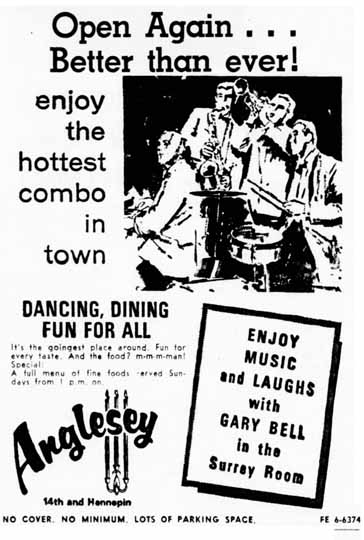
Minneapolis Tribune, July 20, 1963
On November 29, 1963, the R.L. Burns Co. requested that its licenses at the Anglesey Cafe and Bar be transferred to a new corporation called Marro. Marro consisted of Marvin S. Goldman, manager of the Carousel Lounge, operated by his mother, Rose; Sanford Rosen, an accountant; and Israel Mirviss, an attorney. The arrangement was that Marro would lease the Anglesey from the Burns Co. and pay $50,000 for the establishment’s good will. The lease arrangement called for the payment of $61,200 for five years, with an option for an additional five years at $66,000. (Minneapolis Tribune, November 30, 1963)
Will Jones wrote that Marvin Goldman’s first concern would be to restore the Anglesey’s kitchen to its former state of excellence. “Then they’d throw out rock ‘n’ roll and folksingers, redecorate, bring in a dance band specializing in businessman’s bounce, and hope that the place would bounce once more as of yore.” (Minneapolis Tribune, December 5, 1963)
1964
In 1964 there was the Regency Room for dining and dancing and the Surrey Room Piano Bar.
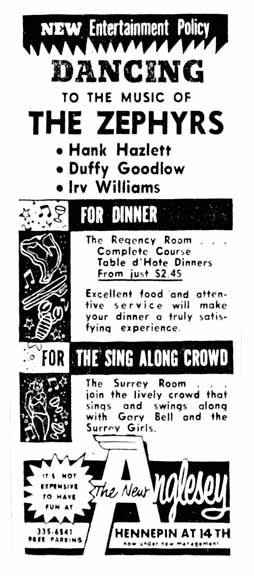
Minneapolis Star, June 25, 1964
In August and September 1964 there was a run of hypnotists to entertain the crowds. Will Jones wrote about the “revived” Anglesey Cafe that was “going in for shows now. Besides the hypnosis, Sherry Seimone was singing, and the Irv Williams-Hank Hazlett combo was playing for dancing. (Minneapolis Tribune, August 12, 1964)
Things moved fast, and by November 1964, we had the Anglesey a Go Go. Shoeshine girl Jack Rubin was spinning records, and hostesses in fringed dresses demonstrated dances, danced with customers, and doubled as waitresses. 1965 was really the year of the Go Go, so they were a titch ahead of the curve. (Will Jones, Minneapolis Tribune, November 12, 1964)
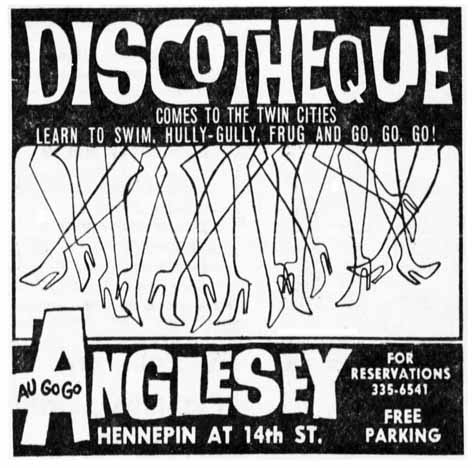
Minneapolis Tribune, November 12, 1964
1965
THE PINK PUSSYCAT
No one tells the story of the transition from the Anglesey to the Pink Pussycat better than the wonderful Mr. Will Jones of the Minneapolis Tribune, so here is his column of March 2, 1965, in full:
Dial the Minneapolis information operator, ask for the Pink Pussycat, and she’ll tell you there’s no such place listed. Well, she just hasn’t caught up with things.
Yes, Minneapolis now has a Pink Pussycat saloon. The sign went up last week, the walls got a new paint job over the weekend, and pretty soon there will be murals showing pussycats both pink and black. And there will be waitresses in Pink Pussycat costumes. This is what has become of the old Anglesey Cafe.
The original Pink Pussycat, in Los Angles, is a combined saloon, striptease parlor, and striptease school where Lenny Bruce’s mother is in charge of the novice stripteasers. On the program there’s always a girl who wears a costume made of pink ostrich-tail feathers, and the customers are allowed to pluck the pink feathers as souvenirs.
In Minneapolis, however, things will be quite different. This one won’t be a strip joint.
The Anglesey abandoned its discotheque policy. The same kind of dancing still goes on, but with a live band, the Belvideres, supplying the music. And there are hostesses to teach the Watusi and the frug.
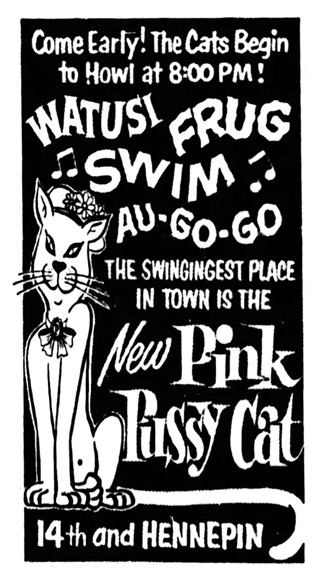
Minneapolis Star, March 12, 1965
OUR SWINGING NIGHT LIFE
The Pink Pussycat was featured on the cover of a special section of the Sunday Tribune Picture Magazine (October 17, 1965) called “Our Swinging Night Life.” Apparently there was at least one guy caught dancing with a woman who was not his wife, and the stuff hit the fan…
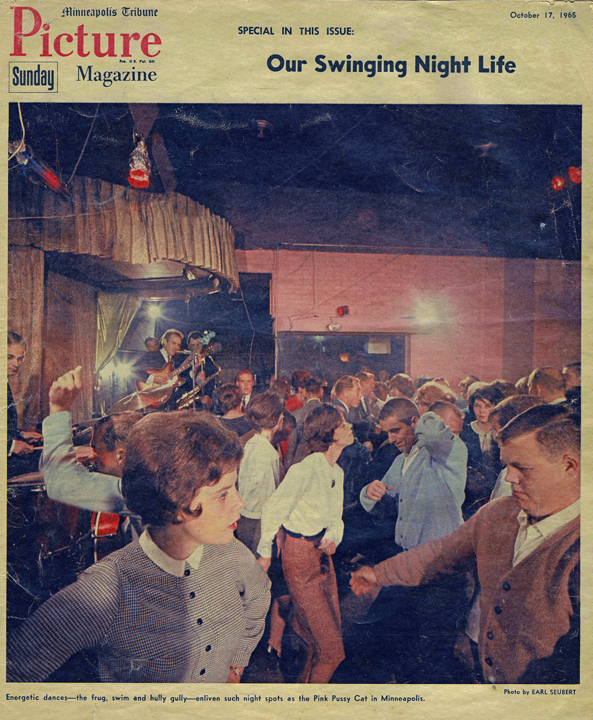
Courtesy Joey Strobel via minniepaulmusic.com
1966
I find quoting Will Jones irresistible. Here is his column of June 14, 1966, where he provides a wealth of information about what must have been an amazing place.
The Pink Pussycat now has go-go girls. That’s not news? I didn’t think so, either, but I have been corrected.
When the Pussycat first went in for the discotheque type of action, it was one of the first places to have waitresses in fringed dresses who would do the new dances with the customers, teaching them, if necessary. Those were not go-go girls, according to the management.
For some weeks, the place has been relying on the customers alone for dance action. And Joey Strobel’s big-band-sound rock with two saxes and an organ alongside the standard guitar and drums, has kept the dance floor packed. The business of the kids not touching each other when they dance just doesn’t work here. The floor is too crowded.
Last week, to amuse those who do not choose to engage in the battle of the dance floor, two authentic go-go girls were installed. They work on table-high platforms in the middle of the room.
When Strobel is on, everything in the room rocks, including the lights. He has a panel of foot switches that control the spotlights on himself, the dance floor, and the go-go girls, and the colored lights flash on and off to the beat, sometimes here, sometimes there. Otherwise, the place is kept candlelight-dark and the waitresses and hostess all carry flashlights.
There used to be a front bar and a back room in the place, but those have disappeared. The walls have been torn out to make one large room. Air conditioning pipes have been exposed, and so has the employes’ time clock in what used to be the kitchen, and the whole place has a stripped-for-action look a little startling to anyone who remembers the old Anglesey Cafe, or even the original Pussycat. There’s rope-at-the-door business on weekends.

Matchbook from the collection of Mark Youngblood
1967
Joey Strobel and the Runaways was basically the house band from the beginning of 1967 until the end of the year, when they moved to George’s in the Park.
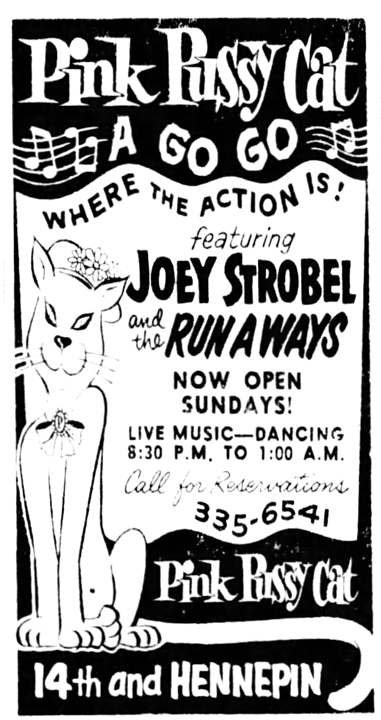
Minneapolis Star, April 20, 1967
1968
BILLY GRAHAM SPOILS THE FUN
On January 17, 1968, the Minneapolis Star announced that a subsidiary of the Billy Graham Evangelistic Association had purchased the Pink Pussycat. The price was not disclosed. The building was slated for demolition, and the site would be used for expansion of the association’s facilities – either a new building or a parking lot. The new owners would take possession of the building on January 28, 1968.
Ads appeared on January 21, 1968, seeking to sell off the Club’s equipment.
The building was demolished in July 1969.
In 1976 the Minneapolis Community and Technical College was built on the entire block.
THE FILLING STATION
Marvin S. Goldman, as head of Marro Corp., still owned the Pink Pussycat business, and his plan was to move the club across Spruce Street to a renovated building at 1401 Hennepin Ave. The Minneapolis City Council had already approved the transfer of the liquor license to the new location. Goldman had hoped to open for business in its new location on January 29, 1968, if his equipment arrived in time. (Minneapolis Star, January 17, 1968)
The new place didn’t turn out to be a new Pink Pussycat and it didn’t open in January, but it turned out to be a successful business for several years.
The building started out as a one-story 48′ by 80′ brick auto shop built in 1904 – this was “automobile row,” after all. In December 1967, Goldman put $42,000 into building a 46′ by 30′ addition and rehabbing the entire place. When Don Morrison saw it he called it a new building.
The Filling Station opened on March 5, 1968. Management seemed to have a proclivity for booking non-local bands.
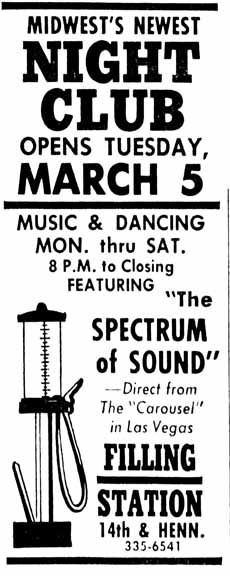
Minneapolis Star, March 4, 1968
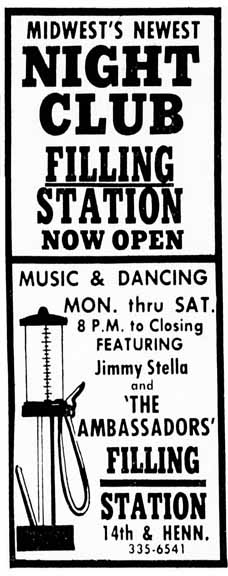
Minneapolis Star, March 8, 1968
Don Morrison gave an excellent description of the club in an early column:
The decor goes with the name without being sticky about it. Door handles are made out of gas nozzles. Lighting fixtures include those flat round glass globes bearing oil company brand names that used to surmount old-fashioned gas pumps.
Goldman said he had hoped to find entire pump units, but that several expeditions around the rural countryside failed to turn up any antiques. But the globes collected by the Winona Light Co. (including one for “Phillips Unique”) are authentic.
The main room is commodious, carpeted and with terraces for tables. There is a dance floor to serve the pop-rock policy of entertainment. A very handsome piano lounge adjoins this area and there also is a street bar for a less musically inclined clientele.
(Minneapolis Star, March 30, 1968)
1969
Here’s an odd name for a female band in an era of women’s liberation. Our local band was called the 19th Amendment, for the Constitutional Amendment that authorized women to vote!

Minneapolis Tribune, January 30, 1969
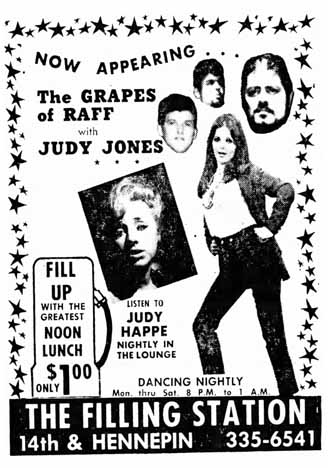
Minneapolis Star, April 25, 1969
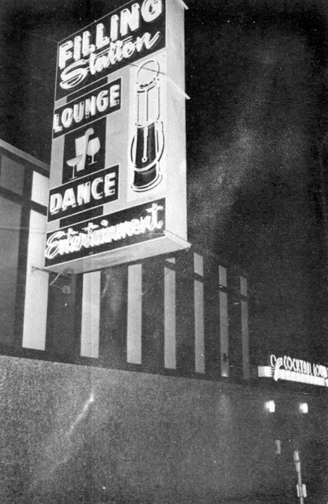
May 1969. Photo copyright Mike Barich
1970
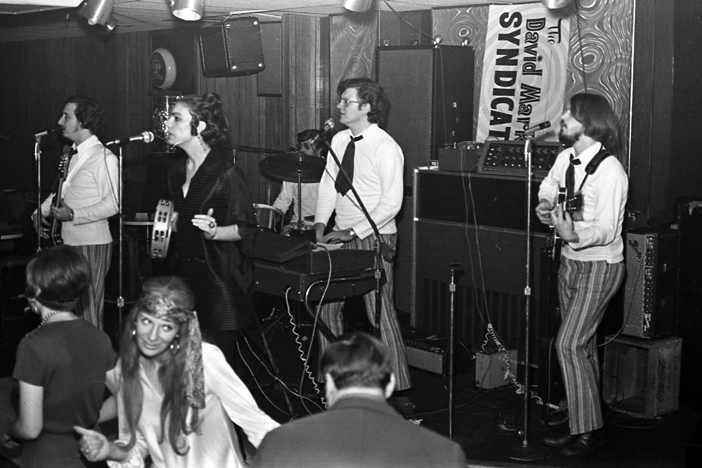
Dave Mark Syndicate, January 28, 1970. Photo copyright Mike Barich
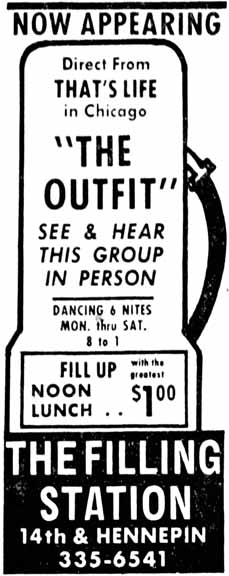
Minneapolis Star, March 6, 1970
Matchbook images below courtesy Deb McKay
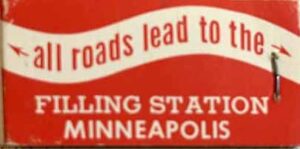
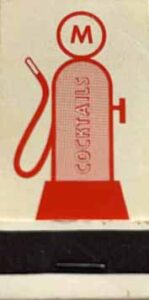
1971
In September 1971, a TV tower was installed, and they began to show NFL football (reservations requested). And had the Filling Station gone Country? The paper’s description still said “Dancing to Rock Band,” but Texas Bill was a Country singer.
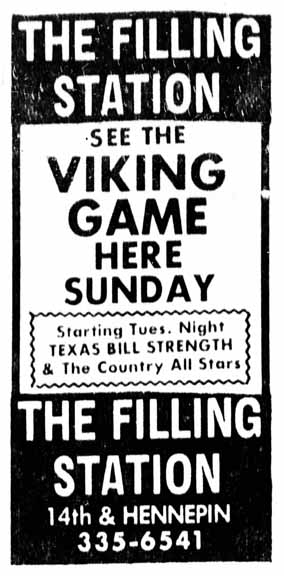
Minneapolis Tribune, November 5, 1971
On November 14, 1971, several bars like the Filling Station that had purchased antennas to pick up local Vikings games that were blacked out on local channels were met with snow or black screens. The theory was that someone from Mason City, Iowa, had planted jammers on their lines so that they could not watch the Minnesota/Green Bay game in the comfort of their local bar instead of at Metropolitan Stadium. Customers were livid, and as the jamming devices were removed, signals were traced to find out who was doing it. The jammer found at the Filling Station was one of three found in the City. Such jammers violated Federal law and the FCC and the FBI got involved with the investigation.
1973
The last classified ad found for the Filling Station in the Minneapolis Star is for a cook, and is dated May 8, 1973.
END OF THE LINE
Like its predecessor, the Filling Station was also doomed to redevelopment. The building was demolished in October 1975. The entire block became the Minneapolis Community/Technical College, built in 1980.
